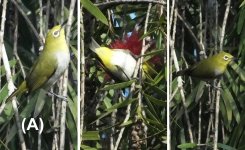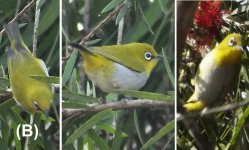Is it possible to say (without using "known" distribution) what these two photos A and B are?
Possibilities are both Japanese, both Oriental, one of each (A or B), or impossible to say from photos.
They were taken in 2 different places in Vietnam. The 3 parts of each photo may be different individuals, since there was a small flock in both cases.
Possibilities are both Japanese, both Oriental, one of each (A or B), or impossible to say from photos.
They were taken in 2 different places in Vietnam. The 3 parts of each photo may be different individuals, since there was a small flock in both cases.







